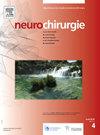Short-segment percutaneous osteosynthesis with long pedicle screw fixation of the injured vertebra for thoracolumbar and lumbar non neurological fractures: The Trident Fixation
IF 1.4
4区 医学
Q4 CLINICAL NEUROLOGY
引用次数: 0
Abstract
Study design
Prospective cohort study
Objective
This study aimed to assess the interest of a short percutaneous monaxial pedicle screw (PS) osteosynthesis, named the Trident Fixation (TF): fixation of one vertebra above and below the vertebral fracture and including two long monoaxial PS into the injured vertebra to treat thoracolumbar (TL) and lumbar (L) fractures.
Methods
Patients operated by this surgical method were prospectively included. Preoperative data and immediate, one-year follow-up, and two-year follow-up postoperative data were collected. The surgical correction was studied, evaluating the radiologic parameters as follows: vertebral body angle, regional traumatic kyphosis, regional traumatic angulation, Anterior/Middle Column Vertebral Body Compression Ratio (VBCR) and Anterior Vertebral Body Compression Percentage and the mid sagittal diameter of the spinal canal. PS placement, bone fusion and the occurrence of instrumentation failure were sought.
Results
Sixty-six patients were included (mean follow-up of 1.9 years (95% CI [1.9–2.6]). Regarding the accurate position of the PS, 11 of them (16.7%) presented a cortical bone violation. At the last follow-up, 3 patients (4.5%) presented a screw loosening, but no one progressed to a screw pull-out. One patient (1.5%) suffered from a rod breakage. All the radiologic parameters improved postoperatively, except the VBCR, which remained unchanged, despite the surgery. Vertebral fracture was healed for 54 patients (82%). Twenty (30.3%) patients presented an intervertebral fusion, either posterior facet fusion (12 patients [18.2%]) or interbody fusion (11 patients [16.6%]).
Conclusion
TF gives relevant postoperative radiological outcomes and is an alternative to the kyphoplasty, which remains an expensive method.
短节段经皮骨融合术联合长椎弓根螺钉固定伤椎体治疗胸腰椎非神经性骨折:三叉戟固定。
研究设计:前瞻性队列研究目的:本研究旨在评估短经皮单轴椎弓根螺钉(PS)骨融合术的应用价值,该技术被命名为三叉戟固定术(Trident Fixation, TF):在椎体骨折上方和下方固定一根椎体,并将两根长单轴椎弓根螺钉置入受伤椎体,用于治疗胸腰椎(TL)和腰椎(L)骨折。方法:前瞻性纳入采用该手术方式的患者。收集术前资料及术后即时、1年随访和2年随访资料。对手术矫正进行研究,评估以下影像学参数:椎体角度、区域性外伤性后凸、区域性外伤性成角、前/中柱椎体压缩比(VBCR)和前椎体压缩百分比以及椎管中矢状径。研究了PS放置、骨融合和内固定失败的发生情况。结果:纳入66例患者(平均随访1.9年(95% CI[1.9-2.6])。在PS的准确位置方面,11例(16.7%)出现皮质骨侵犯。在最后一次随访中,3例患者(4.5%)出现螺钉松动,但没有一例进展到螺钉拔出。1例患者(1.5%)出现棒断裂。术后所有放射学参数均得到改善,除了VBCR,尽管手术仍保持不变。54例(82%)患者椎体骨折愈合。20例(30.3%)患者行椎间融合术,其中12例(18.2%)为后路小关节融合术,11例(16.6%)为椎间融合术。结论:TF可提供相关的术后放射学结果,是后凸成形术的替代方法,后凸成形术仍然是一种昂贵的方法。
本文章由计算机程序翻译,如有差异,请以英文原文为准。
求助全文
约1分钟内获得全文
求助全文
来源期刊

Neurochirurgie
医学-临床神经学
CiteScore
2.70
自引率
6.20%
发文量
100
审稿时长
29 days
期刊介绍:
Neurochirurgie publishes articles on treatment, teaching and research, neurosurgery training and the professional aspects of our discipline, and also the history and progress of neurosurgery. It focuses on pathologies of the head, spine and central and peripheral nervous systems and their vascularization. All aspects of the specialty are dealt with: trauma, tumor, degenerative disease, infection, vascular pathology, and radiosurgery, and pediatrics. Transversal studies are also welcome: neuroanatomy, neurophysiology, neurology, neuropediatrics, psychiatry, neuropsychology, physical medicine and neurologic rehabilitation, neuro-anesthesia, neurologic intensive care, neuroradiology, functional exploration, neuropathology, neuro-ophthalmology, otoneurology, maxillofacial surgery, neuro-endocrinology and spine surgery. Technical and methodological aspects are also taken onboard: diagnostic and therapeutic techniques, methods for assessing results, epidemiology, surgical, interventional and radiological techniques, simulations and pathophysiological hypotheses, and educational tools. The editorial board may refuse submissions that fail to meet the journal''s aims and scope; such studies will not be peer-reviewed, and the editor in chief will promptly inform the corresponding author, so as not to delay submission to a more suitable journal.
With a view to attracting an international audience of both readers and writers, Neurochirurgie especially welcomes articles in English, and gives priority to original studies. Other kinds of article - reviews, case reports, technical notes and meta-analyses - are equally published.
Every year, a special edition is dedicated to the topic selected by the French Society of Neurosurgery for its annual report.
 求助内容:
求助内容: 应助结果提醒方式:
应助结果提醒方式:


